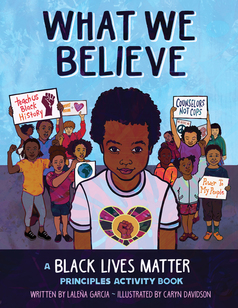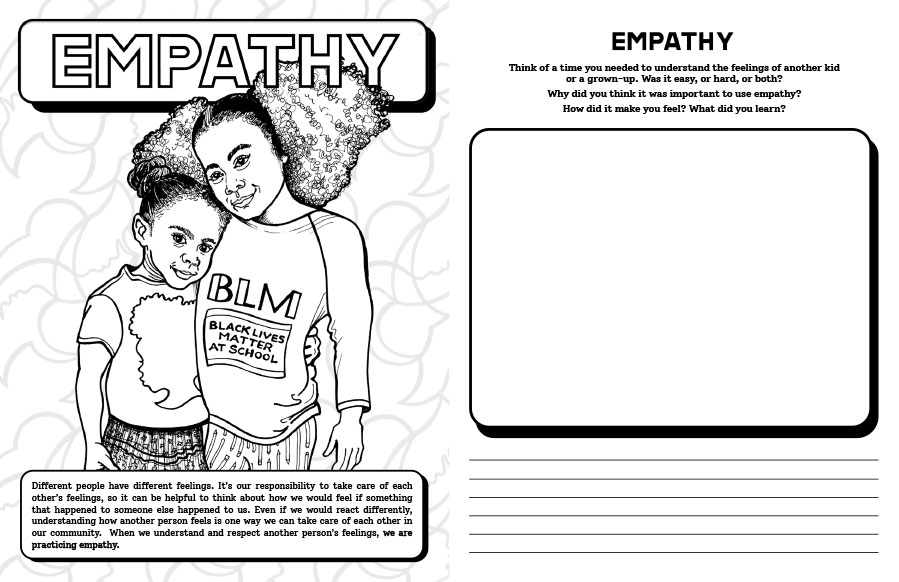What We Believe: A Black Lives Matter Activity Book is a collaboration between Laleña Garcia, who identifies as Black, and Caryn Davidson, who identifies as white. After learning author Laleña Garcia’s story behind What We Believe, we asked the author and illustrator to share a bit about their partnership, and how they define the role of activist and ally.
 How do you define activism?
How do you define activism?
Laleña Garcia: In my school, we talk about activists as people who work together with other people to make the world a better place. We emphasize the importance of collective action and solidarity, and that, even though we sometimes learn about one or two people — like Martin Luther King, Jr. or Rosa Parks — they had to work together with lots of other people to make change.
There’s a part of me that thinks that individual actions — like turning off the lights, recycling, or choosing to buy from BIPOC-owned businesses — is part of being a good, decent, human, but is maybe a little bit different from being an activist, but it’s not something I’m willing to have a fight about. If you’re organizing other people to do those things, or writing letters to people in power to get them to make changes, then I think it’s more like activism, because of the collective nature.
Caryn Davidson: To me, activism is pushing yourself to take a very concrete action in place of only thinking, writing a social media post, or discussing an issue – and part of this MUST include addressing how the issue is manifesting in your very immediate lived reality. I have had too many conversations with people about abstracted systems of racism and injustice, people who are very passionate about helping people negatively impacted by those systems, and yet they are unwilling to confront how those systems are expressed through the behaviors, policies, practices and specifics of their lifestyles, neighborhoods, schools and cities. Activism does require that you look around you to examine who you have relationships with, who you interact with on a daily basis, how you get your food, what goods and services you purchase, what school you choose to attend, work at, or send your kids to, what you choose to ignore about the racial dynamics of the spaces you live, visit and work in, and so on. But it does not only require critically thinking about these realities and manifestations of systemic issues and injustice; it requires changing your behavior, speaking about this to others on a regular basis, and supporting specific policies that will ensure actual equity in all sectors of your life and society at large.
How do you define allyship?
LG: I think being an ally is when you understand that there are oppressions that don’t adversely affect you, maybe even help you, and you still work to dismantle those systems, or to amplify the voices of folks who are impacted. It can get complicated, because giving up power and privilege is hard, and you might not be acting in a way that the person whom you see being oppressed likes, so you have to be willing to accept feedback, and change your actions. I feel allyship is seen in folks’ actions, and often goes unobserved, if it’s real allyship (which can also feel hard; we like folks to notice when we do something that’s hard for us). I think the biggest thing to understand when we’re being allies is that it’s a journey; a process, not a product. It’s ongoing, and we don’t get to rest on our laurels, or decide that because we’re vaulting over the low bars our country sets for us, we don’t have to listen to impacted people. We’re all in need of growth, of constant reflection, and that’s okay.
CD: You have to understand how you will never personally know the experiences of people who are disproportionately, negatively impacted by systems of racism and oppression. BUT you also MUST understand that YOU are ALWAYS ACTUALLY IMPACTED by those systems, and believing that you are not is part of the privileges and power structures upon which those systems are built and maintained. SO, racism affects white people in VERY different ways than it affects BIPOC folx, BUT I know way too many white people whose choice to ignore racism was an extension of their unwillingness to face how it directly informs and impacts every facet of their life. Being an ally means never ignoring race, naming white supremacy and perpetrators of racist violence, naming the slower structural ways that racism is impacting everyone you know – including yourself, and being the kind of person who BIPOC folx know or (in one way or other) eventually can trust will own up to whatever intended or unintended impacts your words and actions may have on them, in a restorative, open, and loving if not transformative way.
In movements that center BIPOC lives and voices, what role should white activists and allies take? In what ways can white allies take the labor (emotional, physical or otherwise) off of BIPOC while continuing to center BIPOC voices and decentering their own?
CD: The Steering Committee of the NYC Black Lives Matter At Schools group has really reckoned with this as a multiracial group, and has functioned according to this very principle. It took some time and it was a challenge in our first year, but we have continually reflected on how we can embody the guiding principles in our organizing. One of the norms is to lift up Black voices in our work together and we continually center the intersectional Black Feminist lens offered by the BLM principles. Meetings are led by Black women in our steering committee, rallies highlight the voices of Black organizers and youth, while white organizers within the group take on whatever is needed to balance the work and support the total wellbeing of BIPOC members.
LG: Exactly! When white folks take notes, or do follow ups, or offer to take on tasks, I feel supported as a Black femme. When I’m asked which aspects of a task I want to and have capacity to take on, and I know that all the other parts will also be taken care of, I feel supported. When groups are concerned with optics, and suddenly I’m pushed to give speeches, or be available, or take on more than I want because there’s one (or two or three) of me and lots of white folks, I do not feel supported. I think it’s critical to understand the folks we’re organizing with as individual people with needs; if we don’t have enough Black folks to facilitate each breakout group, for example, then, sure we should think about the big-picture and figure out why there aren’t enough and work to fix that, while simultaneously not burning out the Black folks we have.
Also, I’m just one Black person, and can’t speak for all Black people; I often like when folks ask me what help I need, but some folks would prefer for others to look around, see what needs doing, and do it. Other concrete examples of things that have felt good to me: Black womxn having the megaphone and leading the chants, while white folks repeat back; white people putting their bodies between me and the police; male colleagues who are called on before me in meetings, saying, “Oh, Laleña’s hand was up first; I’ll go next.”
 Laleña Garcia has taught in New York City early childhood education programs for more than twenty years. What We Believe grew out of her work with Black Lives Matter in Schools, a teachers’ organization striving for racial equity in education, and she has presented at local and national conferences on teaching the principles of the BLM movement to children. A graduate of Yale University and the Bank Street College of Education, she lives in Brooklyn, NY. Please visit her website at rootedkids.org and follow her on Instagram at @blm_in_kindergarten.
Laleña Garcia has taught in New York City early childhood education programs for more than twenty years. What We Believe grew out of her work with Black Lives Matter in Schools, a teachers’ organization striving for racial equity in education, and she has presented at local and national conferences on teaching the principles of the BLM movement to children. A graduate of Yale University and the Bank Street College of Education, she lives in Brooklyn, NY. Please visit her website at rootedkids.org and follow her on Instagram at @blm_in_kindergarten.
 Caryn Davidson studied Anthropology and Visual Art at Brown University and received her MA in Arts Education from NYU. Since the start of her career in education in 2004, she has founded and developed the arts programs at three public schools in New York City, and led initiatives to promote culturally relevant pedagogy and socially just practices within those school communities. She now teaches art at the high school level in Brooklyn, NY, where she also lives. She is a Steering Committee member of the Black Lives Matter at NYC Schools organizing group and a designer for the national Black Lives Matter at Schools movement. Please visit her website at caryndavidson.com and on Instagram at @caryn_arts.
Caryn Davidson studied Anthropology and Visual Art at Brown University and received her MA in Arts Education from NYU. Since the start of her career in education in 2004, she has founded and developed the arts programs at three public schools in New York City, and led initiatives to promote culturally relevant pedagogy and socially just practices within those school communities. She now teaches art at the high school level in Brooklyn, NY, where she also lives. She is a Steering Committee member of the Black Lives Matter at NYC Schools organizing group and a designer for the national Black Lives Matter at Schools movement. Please visit her website at caryndavidson.com and on Instagram at @caryn_arts.









